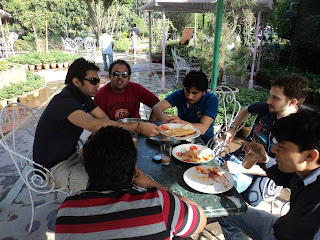I just returned from one of the most random, adventurous weekends of my life. Here are a few highlights (I had to edit this down a lot):
•
A friend and I – along with 9 other guys – rented a converted military van (which came with a driver, who stayed with us all weekend) and hit the road for Rishikesh, a town in the Himalayan foothills on the Ganges River. The trip was supposed to take 6 hours each way, but ended up taking almost 12 due to traffic. We stopped at a Hindu temple on the way, the site of the 1857 Indian revolt against the British. The temple rituals were fascinating -- rubbing wood on sandstone until a paste appeared, rubbing that paste on a rock in the middle of an elaborate jeweled shrine to Shiva, and then pouring water over another shrine to honor the sun. Don't forget to use your right hand.
•
Our encampment was below a winding mountain road, about 1.5 km down the mountainside, across a suspension bridge. It may have been the most isolated spot I've ever visited in my life. There were a few small homes with some goats and stray cows, as well as dozens and dozens of langurs (monkeys) traipsing across the paths. We stayed in a row of tents perched above a sandy white beach on the side of the Ganges. (See pictures.) Almost as soon as we arrived, I split off with two guys in search of a waterfall about 2 km away. The waterfall poured into a small rock formation nestled between the hills and was full of Indian tourists. A lot of my American friends complain about strangers here wanting to take their picture, but oddly, that never happened to me until the waterfall, after I took off my shirt. I'm not sure what to extrapolate from that.
•
While we were at the waterfall, the other guys from our group bathed in the Ganges. They told me that the Ganges in the mountains is pure enough to drink, which they demonstrated several times. Moments later, a family set up a large pile of sticks a few meters away and cremated their relative on the banks of the river. "See that?" I pointed out to my friend, "That's why I don't think the river isn't clean.” That night we laid on the beach, had some drinks, and stared at the stars, the clearest night sky I've seen since last summer in the Sahara. My life has been very unpredictable as of late.
•
The next morning, after a quick game of beach volleyball, we headed off to rappel down a nearby bridge. The guide gave a five-minute speech in Hindi explaining in detail how to use the rappelling gear. My friend then leaned over to me and, by way of translation, said simply, “Be sure to do it properly.” When I pressed him, he continued: “Use one hand for steering, one for sliding.” Ah, much clearer. Once I realized that the guide himself had the power to stop any drop, I felt more comfortable climbing over the railing and leaning backwards off the bridge. Somehow it all worked out. Afterwords, we hiked back to the mountain road and hitched a ride with 20 people standing in the back of a pick-up truck. That may be my most pure-India experience yet.
•
At the next beach, we reached the main event: white water rafting! None of us ever tried that before in our lives, which became readily apparent when six-foot waves crashed into our boat and smacked the sense out of us. I thought I was headed out of the boat at one point, but somehow I kept it together, even as the waves flung our rafting guide himself from the back of the boat directly onto my head. It was pretty intense. I loved it. The rafting ended with a stop to cliff-jump off a 30-foot rock cliff above the water. At that point it seemed worth it to test the water; the jump was very much a once-in-a-lifetime experience.
•
That night we stopped at an ashram in Haridwar, a holy Hindu city down the river from Rishikesh. The ashram was full of people meditating in flowing robes, and everyone seemed very friendly and respectful. It was a change of pace. We sat on rows of carpets with hundreds of others while staff ladled various mixtures (mostly lentil or potato-based) from tin buckets. "Don't forget to eat with your hands," one of the guys told me. I looked at the metal plate and cup in front of me and told him that I didn't see an alternative. Later, another guy told me that I'm "very adaptable." That's one of my favorite compliments since I arrived in India.



































